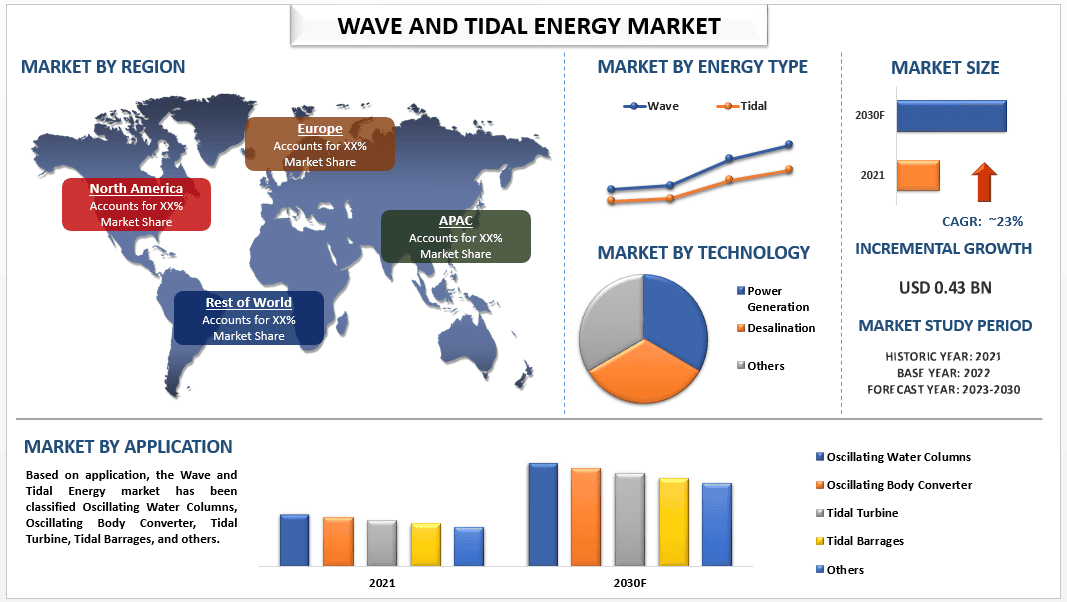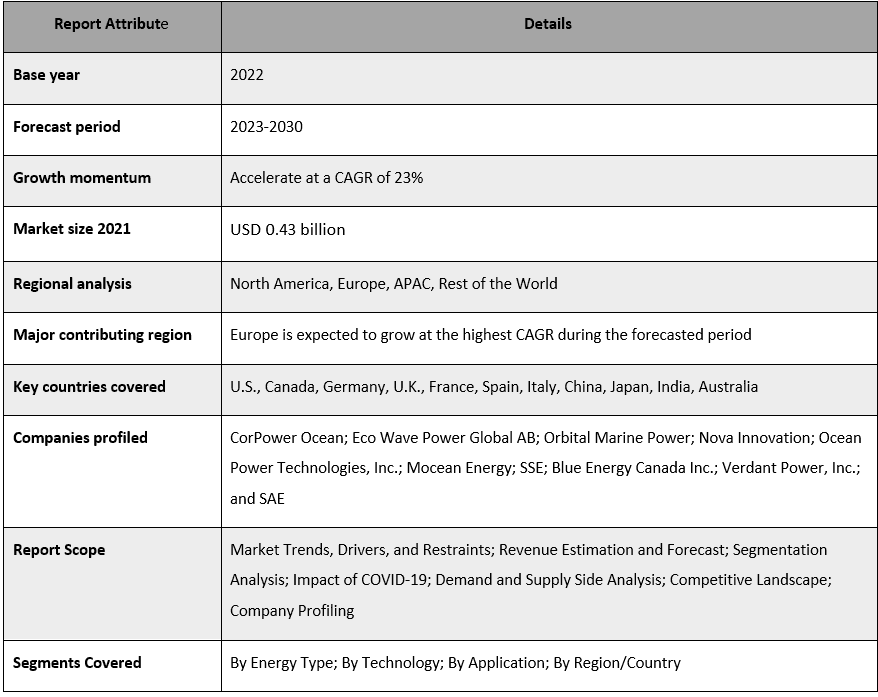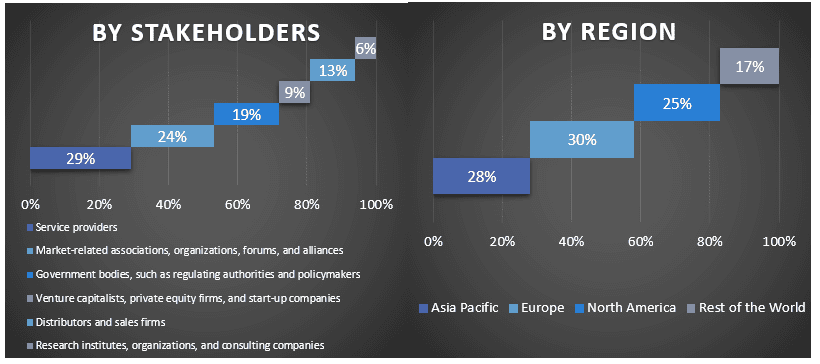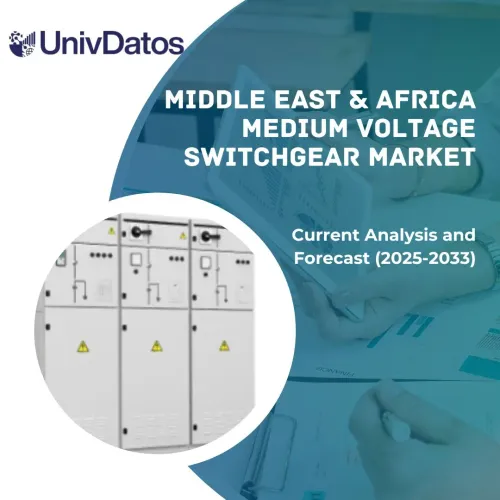- Inicio
- Acerca de nosotros
- Industria
- Servicios
- Leyendo
- Contáctenos
Mercado de la energía undimotriz y mareomotriz: Análisis actual y pronóstico (2023-2030)
Énfasis en el tipo de energía (columnas de agua oscilantes, convertidor de cuerpo oscilante, turbina de marea, represas de marea y otros); Tecnología (generación de energía, desalinización y otros); Aplicación (columnas de agua oscilantes, convertidor de cuerpo oscilante, turbina de marea, represas de marea y otros); y Región/País

Se espera que el Mercado Global de Energía Undimotriz y Mareomotriz crezca a una tasa vertiginosa de alrededor del 23% durante el período de pronóstico. La energía undimotriz y mareomotriz es la energía generada al aprovechar la energía de las olas del océano y convertirla en electricidad. Además, esto involucra un dispositivo llamado convertidor de energía undimotriz WLC), que se coloca en el fondo del océano y utiliza las olas para hacer girar las turbinas y generar electricidad. La energía de las corrientes de marea, impulsadas por la gravedad de la Luna y el Sol, se utiliza para generar electricidad. Esto se hace típicamente usando un dispositivo llamado turbina de marea, que se coloca en el océano y usa el movimiento de los flujos de marea para hacer girar una turbina y generar electricidad.
Se espera que el Mercado de Energía Undimotriz y Mareomotriz crezca a una tasa vertiginosa de alrededor del 23% debido a la creciente demanda de energía junto con la capacidad de reducir las emisiones de gases de efecto invernadero. Se están llevando a cabo importantes lanzamientos en el mercado y se ofrece la creación de características más avanzadas de la energía undimotriz y mareomotriz. Por ejemplo, en enero de 2023, se lanzó un proyecto de USD 11,30 millones para crear las "palas de turbina mareomotriz más grandes del mundo" por la Unión Europea y UK Research and Innovation.
CorPower Ocean; Eco Wave Power Global AB; Orbital Marine Power; Nova Innovation; Ocean Power Technologies, Inc.; Mocean Energy; SSE; Blue Energy Canada Inc.; Verdant Power, Inc.; y SAE son algunos de los actores clave en el mercado. Estos actores han emprendido varias fusiones y adquisiciones junto con asociaciones para facilitar a los clientes productos/tecnologías innovadores y de alta tecnología.
Perspectivas Presentadas en el Informe
"Entre las tecnologías, se espera que la generación de energía crezca con una CAGR significativa durante el período de pronóstico"
Sobre la base de la tecnología, el mercado se clasifica en generación de energía, desalinización y otros. Entre estos, se espera que la generación de energía crezca con una CAGR significativa durante el período de pronóstico. Debido al rápido crecimiento del consumo de electricidad en todo el mundo y al progreso tecnológico. La disponibilidad convencional y alta en comparación con otras fuentes tradicionales de energía renovable, la generación de electricidad a partir del océano ha estado creciendo en un mercado que lleva a mostrar dominio en el futuro. Por lo tanto, la generación de energía undimotriz y mareomotriz ofrece una mejor capacidad de control y rendimiento en el campo.
"Entre las aplicaciones, se espera que la categoría de turbinas mareomotrices crezca con una CAGR significativa durante el período de pronóstico"
Según la aplicación, el mercado de energía undimotriz y mareomotriz se ha clasificado como columnas de agua oscilantes, convertidor de cuerpo oscilante, turbina mareomotriz, represas mareomotrices y otros. Se espera que la categoría de turbinas mareomotrices crezca con una CAGR significativa durante el período de pronóstico. Esto se utiliza principalmente para generar electricidad aprovechando la energía de las mareas oceánicas. Están trabajando utilizando las fuerzas de las mareas para hacer girar el rotor sobre un generador que genera electricidad. Además, es un papel cada vez más importante para satisfacer las necesidades energéticas del mundo al tiempo que reduce las emisiones de gases de efecto invernadero y mitiga los impactos del cambio climático. Por ejemplo, en enero de 2023, se lanzaron USD 11,53 millones en proyectos para crear las "palas de turbina mareomotriz más grandes del mundo.
Cobertura del Informe del Mercado de Energía Undimotriz y Mareomotriz

"Se prevé que Europa crezca a una CAGR sustancial durante el período de pronóstico"
En 2021, se prevé que Europa crezca a una CAGR sustancial durante el período de pronóstico. Esto se debe principalmente a la creciente demanda de energía limpia, los avances en tecnología, las inversiones significativas y las políticas de apoyo. Además, la dependencia de la región de los combustibles fósiles y el logro de sus objetivos climáticos, ha habido una creciente demanda de fuentes de energía renovables. Se establece el objetivo de la UE de reducir las emisiones de gases de efecto invernadero al 55% para 2030, y se espera que las energías renovables, como la energía eólica y undimotriz, sean un factor importante para alcanzar este objetivo. Además, los principales proyectos en el mercado continúan invirtiendo en el lanzamiento de energía undimotriz a gran escala. Por ejemplo, en octubre de 2022, se lanzó un nuevo proyecto de cuatro años para probar la viabilidad de la energía undimotriz a gran escala en Europa con una inversión de USD 19,3 millones.
Razones para comprar este informe:
- El estudio incluye el dimensionamiento del mercado y el análisis de pronóstico validado por expertos clave autenticados de la industria.
- El informe presenta una revisión rápida del rendimiento general de la industria de un vistazo.
- El informe cubre un análisis en profundidad de los pares prominentes de la industria con un enfoque principal en las finanzas comerciales clave, las carteras de productos, las estrategias de expansión y los desarrollos recientes.
- Examen detallado de los impulsores, restricciones, tendencias clave y oportunidades que prevalecen en la industria.
- El estudio cubre de manera integral el mercado en diferentes segmentos.
- Análisis profundo a nivel regional de la industria.
Opciones de personalización:
El mercado global de energía undimotriz y mareomotriz se puede personalizar aún más según los requisitos o cualquier otro segmento del mercado. Además de esto, UMI entiende que puede tener sus propias necesidades comerciales, por lo tanto, no dude en conectarse con nosotros para obtener un informe que se adapte completamente a sus requisitos.
Tabla de contenido
Metodología de investigación para el análisis del mercado de la energía undimotriz y mareomotriz (2023-2030)
El análisis del mercado histórico, la estimación del mercado actual y la previsión del mercado futuro del mercado mundial de la energía undimotriz y mareomotriz fueron los tres pasos principales que se llevaron a cabo para crear y analizar la adopción de la energía undimotriz y mareomotriz en las principales regiones del mundo. Se llevó a cabo una exhaustiva investigación secundaria para recopilar las cifras históricas del mercado y estimar el tamaño actual del mercado. En segundo lugar, para validar estas ideas, se tomaron en consideración numerosos hallazgos y supuestos. Además, también se realizaron exhaustivas entrevistas primarias con expertos de la industria en toda la cadena de valor del mercado mundial de la energía undimotriz y mareomotriz. Tras la suposición y validación de las cifras del mercado a través de entrevistas primarias, empleamos un enfoque de arriba abajo/de abajo arriba para pronosticar el tamaño completo del mercado. Posteriormente, se adoptaron métodos de desglose del mercado y triangulación de datos para estimar y analizar el tamaño del mercado de los segmentos y subsegmentos de la industria en cuestión. La metodología detallada se explica a continuación:
Análisis del tamaño histórico del mercado
Paso 1: Estudio profundo de fuentes secundarias:
Se realizó un estudio secundario detallado para obtener el tamaño histórico del mercado de la energía undimotriz y mareomotriz a través de fuentes internas de la empresa, como informes anuales y estados financieros, presentaciones de rendimiento, comunicados de prensa, etc., y fuentes externas, incluidos revistas, noticias y artículos, publicaciones gubernamentales, publicaciones de la competencia, informes del sector, bases de datos de terceros y otras publicaciones creíbles.
Paso 2: Segmentación del mercado:
Después de obtener el tamaño histórico del mercado de la energía undimotriz y mareomotriz, realizamos un análisis secundario detallado para recopilar información histórica del mercado y compartirla para diferentes segmentos y subsegmentos para las principales regiones. Los principales segmentos incluidos en el informe son el tipo de energía, la tecnología y la aplicación. Además, se realizaron análisis a nivel de país para evaluar la adopción general de modelos de prueba en esa región.
Paso 3: Análisis de factores:
Después de adquirir el tamaño histórico del mercado de diferentes segmentos y subsegmentos, realizamos un análisis de factores detallado para estimar el tamaño actual del mercado de la energía undimotriz y mareomotriz. Además, realizamos un análisis de factores utilizando variables dependientes e independientes, como los diversos tipos de energía, la tecnología y la aplicación de la energía undimotriz y mareomotriz. Se realizó un análisis exhaustivo de los escenarios del lado de la demanda y de la oferta teniendo en cuenta las principales asociaciones, fusiones y adquisiciones, la expansión empresarial y los lanzamientos de productos en el sector del mercado de la energía undimotriz y mareomotriz en todo el mundo.
Estimación y previsión del tamaño actual del mercado
Tamaño actual del mercado: Basándonos en la información práctica de los 3 pasos anteriores, llegamos al tamaño actual del mercado, a los principales actores del mercado mundial de la energía undimotriz y mareomotriz y a las cuotas de mercado de los segmentos. Todos los porcentajes de participación requeridos y los desgloses del mercado se determinaron utilizando el enfoque secundario mencionado anteriormente y se verificaron a través de entrevistas primarias.
Estimación y previsión: Para la estimación y previsión del mercado, se asignaron ponderaciones a diferentes factores, incluidos los impulsores y las tendencias, las restricciones y las oportunidades disponibles para las partes interesadas. Después de analizar estos factores, se aplicaron técnicas de previsión relevantes, es decir, el enfoque de arriba abajo/de abajo arriba, para llegar a la previsión del mercado para 2030 para diferentes segmentos y subsegmentos en los principales mercados a nivel mundial. La metodología de investigación adoptada para estimar el tamaño del mercado abarca:
- El tamaño del mercado de la industria, en términos de ingresos (USD) y la tasa de adopción del mercado de la energía undimotriz y mareomotriz en los principales mercados nacionales
- Todas las cuotas porcentuales, divisiones y desgloses de los segmentos y subsegmentos del mercado
- Actores clave en el mercado mundial de la energía undimotriz y mareomotriz en términos de productos ofrecidos. Además, las estrategias de crecimiento adoptadas por estos actores para competir en el mercado de rápido crecimiento
Validación del tamaño y la cuota de mercado
Investigación primaria: Se realizaron entrevistas en profundidad con los líderes de opinión clave (KOL), incluidos los ejecutivos de alto nivel (CXO/VP, jefe de ventas, jefe de marketing, jefe de operaciones, jefe regional, jefe de país, etc.) en las principales regiones. Los resultados de la investigación primaria se resumieron y se realizó un análisis estadístico para demostrar la hipótesis establecida. Las aportaciones de la investigación primaria se consolidaron con los resultados secundarios, convirtiendo así la información en información práctica.
División de los participantes primarios en diferentes regiones

Ingeniería de mercado
Se empleó la técnica de triangulación de datos para completar la estimación general del mercado y para llegar a cifras estadísticas precisas para cada segmento y subsegmento del mercado mundial de la energía undimotriz y mareomotriz. Los datos se dividieron en varios segmentos y subsegmentos después de estudiar varios parámetros y tendencias en las áreas de tipo de energía, tecnología y aplicación en el mercado mundial de la energía undimotriz y mareomotriz.
El objetivo principal del estudio del mercado mundial de la energía undimotriz y mareomotriz
Las tendencias actuales y futuras del mercado mundial de la energía undimotriz y mareomotriz se identificaron en el estudio. Los inversores pueden obtener información estratégica para basar su criterio para las inversiones en el análisis cualitativo y cuantitativo realizado en el estudio. Las tendencias actuales y futuras del mercado determinaron el atractivo general del mercado a nivel regional, proporcionando una plataforma para que el participante industrial explote el mercado sin explotar para beneficiarse de una ventaja de ser el primero en actuar. Otros objetivos cuantitativos de los estudios incluyen:
- Analizar el tamaño actual y previsto del mercado de la energía undimotriz y mareomotriz en términos de valor (USD). Además, analizar el tamaño actual y previsto del mercado de diferentes segmentos y subsegmentos
- Los segmentos del estudio incluyen áreas de tipo de energía, tecnología y aplicación.
- Definir y analizar el marco regulatorio para la energía undimotriz y mareomotriz
- Analizar la cadena de valor involucrada con la presencia de varios intermediarios, junto con el análisis del comportamiento de los clientes y competidores de la industria.
- Analizar el tamaño actual y previsto del mercado de la energía undimotriz y mareomotriz para la región principal.
- Los principales países de las regiones estudiadas en el informe incluyen Asia Pacífico, Europa, América del Norte y el resto del mundo.
- Perfiles de empresas del mercado de la energía undimotriz y mareomotriz y las estrategias de crecimiento adoptadas por los actores del mercado para mantenerse en el mercado de rápido crecimiento
- Análisis profundo a nivel regional de la industria
Relacionados Informes
Los clientes que compraron este artículo también compraron










